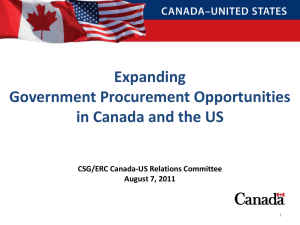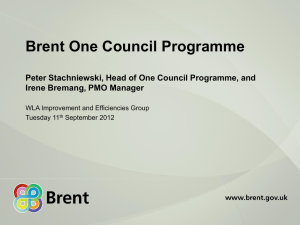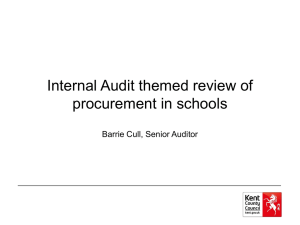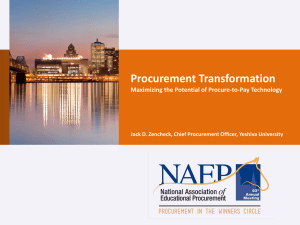Document
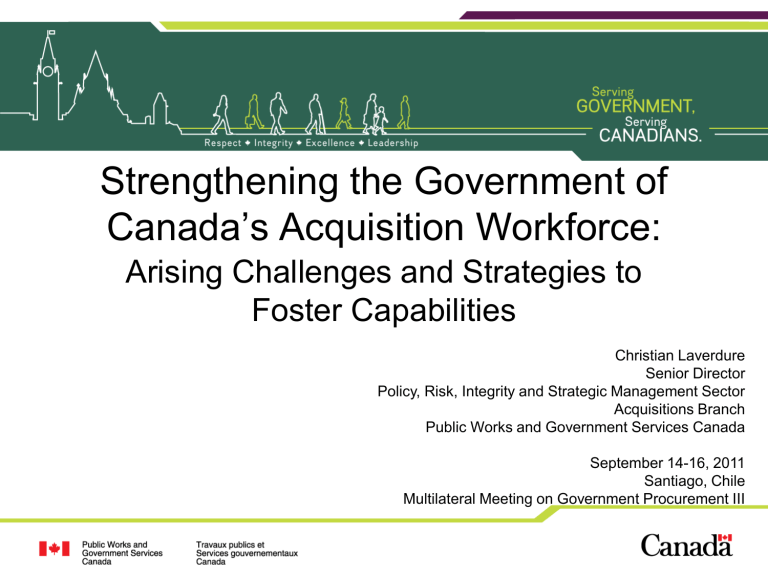
Strengthening the Government of
Canada’s Acquisition Workforce:
Arising Challenges and Strategies to
Foster Capabilities
Christian Laverdure
Senior Director
Policy, Risk, Integrity and Strategic Management Sector
Acquisitions Branch
Public Works and Government Services Canada
September 14-16, 2011
Santiago, Chile
Multilateral Meeting on Government Procurement III
Purpose
• To describe efforts to strengthen acquisition capacity throughout the Canadian government in a context of:
– Demographic change
– Renewal of the workforce
– Renewal of the acquisition function
2
Acquisitions in Canada: Key
Demographics (Resource Distribution)
• The number of employees in the PG classification increased from 2,096 in 2000 to 3,234 in
March 2009 (54% increase).
Departmental distribution for the PG group, March 2009
DND, 751 (23.2%)
PWGSC, 1,479
(45.7%)
• Nearly half (45.7%) of all PG employees work for PWGSC, followed by the Department of
National Defence (23.2%) and
31.0% among other federal organizations 1 .
1 PG Workforce Profile, Centre for Workforce Analysis and Forecasting, Statistics Canada, 2010
Other Deps, 1004
(31.0%)
3
Acquisitions in Canada: Key
Demographics (Employee Turnover)
• Between 2005 and 2009, average years of service decreased from 18.2 to
15.0.
• The proportion of employees with less than 10 years of service increased from 27.1% to 48.5%, with 44.5% of PG-04 (working level) employees having less than 10 years of service 1 .
• Additionally, 280 Acquisitions Branch PG employees and 339 employees
(21.7%) in all classifications within AB will be eligible for retirement by
March 31, 2014 2 .
• These employees are primarily located in the more senior ranks:
– 62 of 152 PG-06s (40.8%);
– 92 of 314 PG-05s (29.3%);
– Additionally, of the 52 executives at AB, approximately half will be retirement eligible by 2014.
1 PG Workforce Profile, Centre for Workforce Analysis and Forecasting, Statistics Canada, 2010
2 Data extracted from PWGSC Human Resources Management System, July 2011
4
Acquisitions Environment in Canada
• More emphasis on high-risk, high-complexity procurement:
– Military acquisitions
– Technological renewal
– Volume of high-complexity procurement has doubled in the last 20 years
• More emphasis on bundling and commoditizing low-dollar value, low complexity procurement activities:
– Standing offers
– Online tools
– Commodity management approaches for widely purchased goods and services
5
Capacity Issues
• There is a need for highly qualified, educated and trained personnel to transform the acquisitions function from a transactional service to a strategic, value added function to support government priorities.
• A substantial amount of personnel meeting this profile have either already retired or will be retirement eligible within 4-5 years.
• There are currently no Canadian university-level degrees that offer a specialization in public procurement – it takes years of training to gain an acceptable degree of specialization.
• New employees are being promoted more quickly to fill gaps and do not have the necessary experience to take on more complex projects.
• There is little competition for senior-level positions; in some cases, positions sit vacant with no one qualified to occupy them.
• Federal departments are in competition with one another and with other jurisdictions for scarce resources.
6
Capacity Building Strategies:
Recruitment
• PWGSC’s Intern Officer program recruits high-potential candidates from a variety of university programs (business, sciences, engineering, etc.) and trains them to become procurement officers.
– 20-25 candidates are recruited a year for the 3-year development program
– Competitive salary
– Trainees are eligible for 40 days of specialized training (in addition to departmental training) and have access to a working-level
“buddy” as well as coaches and mentors
– The program has been in existence for over 50 years; many senior managers in the Canadian federal procurement community are former Intern Officers.
– Program success has led to discussions on expanding the program government-wide.
7
Capacity Building Strategies:
Certification
• The Functional Specialist Certification Program for Procurement,
Materiel Management and Real Property Professionals was developed to professionalize the PG cadre and standardize professional development across government:
– Specialized course curriculum
– Knowledge exams
– Written achievement records
– Competency-based learning
– Transferable across the federal government
• The program is managed by the Treasury Board of Canada Secretariat, with Public Works and Government Services Canada and the Canada
School of Public Service as service providers
8
Capacity Building Strategies:
Community Development
• A government-wide governance structure is in place for the
Procurement, Materiel Management and Real Property
(PMMRP) Community:
– Managed by Treasury Board of Canada Secretariat
– Participation from all federal departments and agencies with significant amount of procurement officers
– Interdepartmental working groups are struck to work on communitywide issues:
• Standardized competency profiles
• Standardized recruitment/hiring tools and collective staffing initiatives
• Professional development curriculum
• Trend analysis
• Government-wide branding 9
Community Development Maturity Model
3
The maturity level reflects the degree to which the community is managed in a systematic and process oriented way.
Examples of activities at each level:
Level 5 – Optimized at
Enterprise Level
Most organizations are committed to collective community management and respect established processes. Stable funding is in place and the cultural/behavioural shift is evident. Continuous improvement is integrated into processes.
Level 4 – Community
Acceptance
The community is managed in a widely accepted, systematic way.
Over 50% of organizations are actively engaged. Enabling tools, community-wide HR plans and Strategic employee development programs are in place.
Level 3 – Initial: Beginning
Program Development
Beginning of a collective approach to community management. Some working groups have been established; participation in community-wide program development is becoming a recognized job responsibility; and, some community-wide tools are being jointly developed.
Level 2 – Awareness
Departments/agencies understand the need for collective community management and are starting to work together on selected issues. Some processes are established, but the cultural shift to working collaboratively has not been integrated. Community needs are being identified.
Level 1 – Ad-hoc A few departments/agencies may work together on some issues related to strengthening the HR community. Joint initiatives are normally reactive”. No community-wide strategies are in place.
Level 0 –
Not Measurable
No evidence of community-wide programs or initiatives.
3 Model acquired from Treasury Board Secretariat of Canada, Office of the Comptroller General
10
Capacity Building Strategies:
Next Steps
• Strengthen branding of the public procurement community
– Attend additional career fairs
– Negotiate additional co-op agreements with post-secondary institutions
• Develop additional training courses and programs
– Further standardize training curricula
• Harmonize initiatives with Canadian public procurement community
– Pursue community-wide standards and best practices
– Encourage portability of public procurement credentials
– Make a case for developing university-level specialized courses via a unified public procurement community
11
Questions?
12



